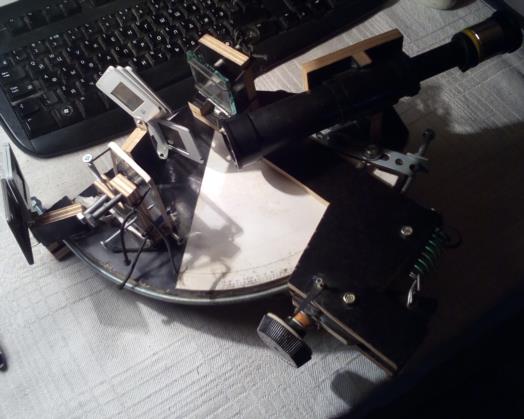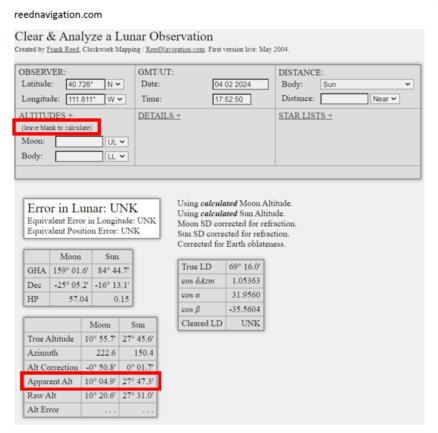
NavList:
A Community Devoted to the Preservation and Practice of Celestial Navigation and Other Methods of Traditional Wayfinding
From: Modris Fersters
Date: 2024 Feb 17, 10:30 -0800
Dear, Homer
You wrote: “I live inland where I don't have a true horizon that I can use, so my actual sextant work is limited”
Don’t worry about lack of sea horizont. Most of my sextant hobbyist’s observations are made without the sea horizon and I dont’ feel limited by this.There are enough alternatives, for example:
1) you can use an artifical horizon. This is mainly actual if you want to get real observed altitudes. In case of lunars these altitudes are not needed to be extremely accurat (usually some minutes of arc does not matters much). For lunar altitudes I use very primitive mirror artificial horizon, roughly leveled by spirit level. For this purpose almost any mirror is suitable, because the accuracy is not so important.
2) you can calculate the altitudes manually or by the help of digital tools.
You wrote: “My sextant is a Davis 25 which only has a 3X scope. I haven't adjusted it in a while, but I try to handle it carefully (no index error, I'm assuming)”.
If you use a plastic sextant there should not be very high expectations regarding lunar accuracy. But it does not mean that it is impossible to experiment with lunars. I don’t own a plastic sextant, but I had constructed several home made instruments in the past that allowed practicing lunar sights when I had no metal sextant in my possession (see attached image). Although the absolute value of the measured angle was several arcminutes in error, my home made instruments allowed to fix lunar distance changes during one observation set quite accurately. The main problem was instrument’s sensitivity to temperature and humidity.
3x telescope is not a problem. Especially for the first attempts, because powerful scope makes the observations harder. 3x power scope is adequat enough for lunars too.
But your index error is something that needs attention (it seems that you didn't checked IE). Especcially if you use plastic sextant. In this case index error should be checked befor and after every observation.
You wrote: “I couldn't use my sextant to measure the sun and moon altitudes, so I thought I would use Stellarium to get them”.
If you are going to use Frank’s digital tools then you can get the altitudes out of them too. (I am attaching an example). You open reednavigation.com, then go to “App’s and Tools”. And choose “ Analyse Lunars online”. There you leave blank fields (for altitudes) and the program will calculate altitudes for your position.
You wrote: “The values that I get for the alt sun (apparent) and alt moon (apparent) are a little higher than the displayed values when the effect of the atmosphere is turned off - so this setting seems to eliminate the need to correct for refraction. Is this correct? Also, do I need to do S.D. corrections for the sun and moon, or are the altitudes calculated based on the center of the bodies?”
If you are going to use only apparent altitudes for clearing lunars (as in your mentioned Thomson's method), then you should look for Stellarium altitudes with atmosphere turned on; and you don’t need any corrections. And YES, these are altitudes of the center.
I don’t no what is Frank’s method (I suspect that this is the same historic Thomson’s method with modernized tables), but as far as I understood you are going to try some paper lunar clearing method. And later you will check the results comparing them with Frank’s digital tool results. The best thing is that these operations are independent of your observational errors. You can check your own calculations no matter how good or bad your observations were. And don't get worried if your first experiments with lunars are not very accurate!
Good luck to You!
Modris Fersters








